The Glass Menagerie
Written by Tennessee Williams
Directed by Óran O'Rua
Performed in the
The Mill Theatre, Dundrum - Wednesday 20 to Saturday 23 March 2013
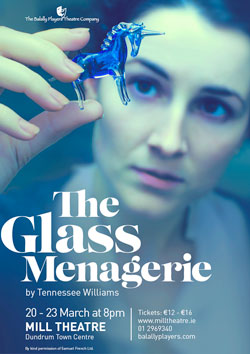
'The Glass Menagerie', written by Tennessee Williams, is a memory play. Williams wrote a screenplay for MGM and the film version became 'The Gentleman Caller'. The first performance of the play was in Chicago in 1944.
The first in a series of some of the most celebrated plays in American theatre, 'The Glass Menagerie' was based on a short story 'Portrait of a Girl in Glass' which he wrote a year earlier, but was not published until 1948.
The play is written from the point of view of narrator Tom Wingfield, and many have seen it as an autobiographical play with clear references to Williams' own life. The playwright's real name was Thomas. However, some commentators suggest that the character of Laura, rather than Tom, more closely resembles Williams himself. This is because of his introvert personality and preoccupation with one thing, writing, almost to the exclusion of everything else. In the play, Laura is fixated on her collection of glass animals.
The play is a compelling portrait of an American family as it tries to balance a difficult past and an uncertain future. It has become known and loved for its strong characters and well written dialogue. It is admired and returned to time and again because it is a great story expertly transformed into one of the best plays of the twentieth century.
"Heaven have mercy! - You're a Christian martyr, yes, that's what you are."
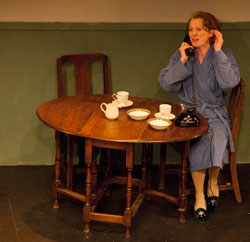
Amanda (Claire O'Donovan) talks to lda Scott about her subscription to the 'Companion' magazine.
The mother in the play, Amanda, is what has been termed 'a Tennessee Williams faded belle'. She grew up in a well-to-do family in the South of the United States of America. Her comfortable upbringing suffered a reversal of economic and social fortune and she has had a difficult time coming to terms with her new position in society. Keeping a veneer of genteel manners on surroundings that are anything but that, adds to the normal drama of life in the Wingfield household and it heightens its tragic and comic aspects.
Amanda is an unbridled extrovert, but stoically sacrifices much for her loved ones. She takes on the job of subscription sales for the 'Homemaker's Companion' magazine to earn some money and help Laura's marriage prospects, without complaining.
In common with her children, she escapes the humdrum world she inhabits by withdrawing into fantasy; and in doing so, she has some of the most colourful and memorable lines in the play.
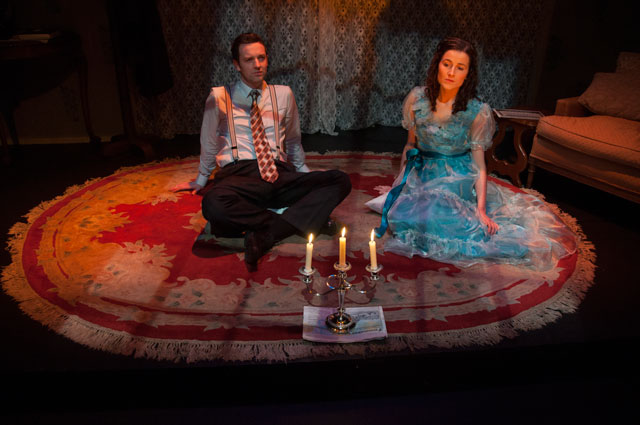
Jim (Declan O'Loughlin) with Laura (Caitlín Higgins Ní Chinnéide) in the final scene of 'The Glass Menagerie' on Saturday 23 March 2013 in the Mill Theatre, Dundrum, Dublin.
While Laura has the least to say, her character is the pivot around which the story and the other characters revolve. In common with the others, she has her problems, but she is entirely selfless and never does anything to manipulate or hurt anyone. She is the focal point for some of the most memorable symbols presented in the story - the rare blue roses, the fragile, brittle glass unicorn, indeed the entire delicate glass menagerie.
Jim O'Connor is the "Gentleman Caller", who works with Tom and is sought by Amanda for her only daughter Laura. He is also a reminder of when, as Amanda recalls, "mother received seventeen gentlemen callers! Why, sometimes there weren't chairs enough to accommodate them all". Jim shares Amanda's outgoing nature and he believes in self-improvement. Tom describes him in a way that paints a picture of a perfect person, but also suggests that he is somehow more 'real' than the other characters. In this play of metaphors, where Tom says "I have a poet's weakness for symbols", Jim represents aspiration and an ideal.
"People go to the movies instead of moving!"
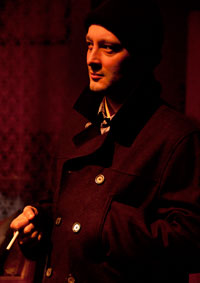
Tom (Seán Ahern)
Unlike the other characters, Tom sometimes speaks directly to the audience. His recollections, delivered as monologues, open and close the play and occasionally comment on it throughout.
His mature reflections on life and living, in the small, claustrophobic apartment home with his mother and sister, are juxtaposed with his less measured actions in the story. While that might make his character less well defined, it also suggests the way memory distorts truth as it 're-members' the fragments of experience, thought, emotion and judgement that contribute to its formation.
If the play is viewed as partly autobiographical, Tom represents Williams himself. If not, it at least echoes aspects of his youth, which he spent in St. Louis, living with an unstable mother and sister and without his father, who was frequently absent.
The use of music and projected images above the set
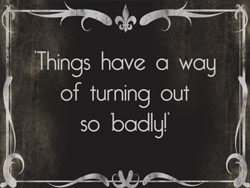
One of the 'legends', as Williams describes them in the script, which were projected on a screen above the set.
Many performances of 'The Glass Menagerie' follow a version of the script that is based on the dialogue and staging of the first production. The version used for this production is the one published in collections of Williams' works and is believed to be the one that he preferred. The playwright's version is less realistic in its staging and lighting. The other significant difference is in the use of a screen on which words and images are periodically projected. The director of the first production, Eddie Dowling, did not like the use of the screen and many subsequent productions have followed that lead.
This Balally Players production, directed by Óran O'Rua, took the script as written and based its non-realistic presentation around Williams' original intention. The images were a combination of photographs and 'legends', which Williams wanted done in the style of silent movie caption cards. While critics of the projections see them as distractions, others find that they serve to mark key moments in this memory play or underscore particular lines. The images also suggest how 'coloured' and embellished are the recollections of some of the characters. Another role played by the projections is to counterpoint the tragic and comic elements in the story with the wry thoughts of its narrator, Tom, or the writer himself.
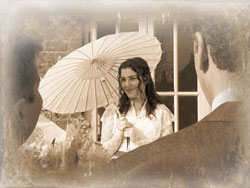
Amanda as a young woman greeting Gentlemen Callers. One of several images created for the projections by Declan Brennan.
Music and atmospheric sounds were also important components that Williams wanted used to punctuate some of the scenes and to act as seamless transitions between them, in much the same way as cinema uses sound. A subtle difference between the audio and the visual devices is that, unlike written words and images, music connects directly with subconscious emotions and communicates without conscious interpretation. That may explain why some are happy to keep the music and the lighting, but not the projected text and images. It was interesting to note from feedback after performances of this production that the majority favoured the projections. Many comments noted how all elements - the set, the costumes, the lighting, the music and the projections - worked with the strong performances of the actors to create an absorbing and believable environment for a great story and a wonderful evening at the theatre.
Tennessee Williams (1911-1983)
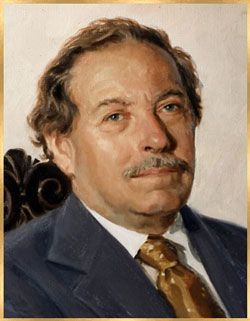
The writer, Thomas Lanier 'Tennessee' Williams III, worked principally as a playwright in the American theatre. He also wrote short stories, novels, poetry, essays, screenplays and a volume of memoirs. His published writing spans half of the twentieth century from the mid-1930s up until his death in 1983. Many of his plays are regarded as classics of the American stage. He also adapted much of that work for the cinema.
'The Glass Menagerie' was successfully produced in Chicago in the winter of 1944–45. It later became a huge hit on Broadway, where it enjoyed a long run. Commenting on how the playwright used relationships known to him through his own family, the director of many of his plays, Elia Kazan, said: "Everything in his life is in his plays, and everything in his plays is in his life." 'The Glass Menagerie' won the New York Drama Critics' Circle Award for best play when it was first produced there.
His reputation was firmly established with his next play 'A Streetcar Named Desire', in 1947. Other successes, which were also brought to the cinema included 'Cat on a Hot Tin Roof' (1955) and 'The Night of the Iguana', a play based on a short story he wrote in 1948. That play opened on Broadway in 1961 and two film adaptations were made, one of which won an Academy Award in 1964.
However, in spite of his critical and commercial success, he was troubled with doubt and insecurity and feared that he would not be able to duplicate his earlier successes. His sister suffered from schizophrenia, was lobotomised and committed to an institution where Williams visited her and paid for her care. She died in 1996. The longest and closest personal relationship in his life was with his partner, Frank Merlo, an actor who later became his personal assistant. Williams cared for him when he was diagnosed with lung cancer, from which he died in 1963. Such sadness only served to compound his own tendency towards depression and fear of insanity. His later years saw him struggle with increasing drug use, much of it prescribed. While he continued to write to the end of his life, he noted that "the critics are out to get me. [...] They make comparisons with my earlier work, but I'm writing differently now". The difference was not appreciated as much as the former glory.
At the time of his death, Williams had been working on his last play, 'In Masks Outrageous and Austere'. The play finally received its world premiere in New York City in April 2012, directed by David Schweizer and starring Shirley Knight as Babe.
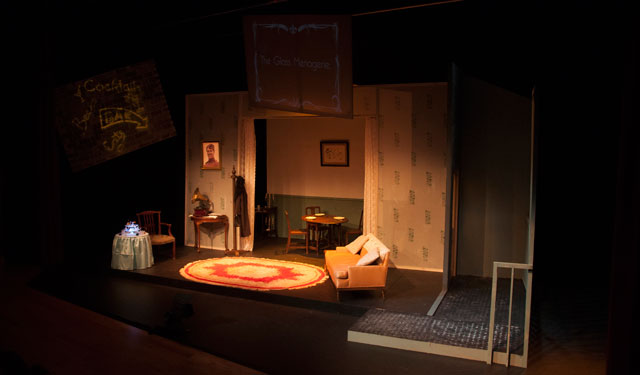
The view of 'The Glass Menagerie' set from the Mill Theatre Auditorium, showing the screen in the centre onto which the legends, in the style of silent movie caption cards, and other images were projected.
|
Tom Wingfield Amanda Wingfield Laura Wingfield Jim O'Connor |
Seán Ahern Claire O'Donovan Caitlín Higgins Ní Chinnéide Declan O'Loughlin |
|
Director Stage Manager Assistant Stage Managers Set and Costume Design Set Construction Lighting Design Sound and Digital Media Design Make-up Publicity and Marketing Poster Design and Photography Programme and Photography |
Óran O'Rua Jean Monahan Doris Cullen Orla Cooney Lorraine O'Hagan Aoife Braiden Dympna Murray Patrick Hand Nollaig Molloy John Carleton Barry Donaldson Declan Brennan Teresa Dempsey Muriel Caslin-O'Hagan Joanne Keane Rebecca Pitt Declan Brennan |
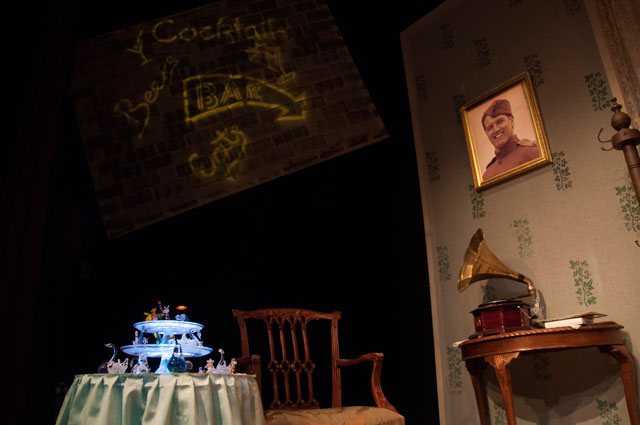
Another view of 'The Glass Menagerie' set from the stage in the Mill Theatre
'The Glass Menagerie' programme
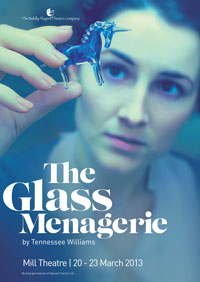 Programme cover
Programme coverThe 'The Glass Menagerie' programme is available here as a PDF document using the link below.
The file name is The_Glass_Menagerie_A5_programme.pdf and its size is 1.07MB.
To open the document in a separate browser tab, left-click on the link above. To download a copy of the PDF file, right-click on the link and select "Save as....."
The programme was produced by Declan Brennan and used the poster image on the cover (left), which was created by Rebecca Pitt.
The programme was printed as a 4-page A5 document (folded A4). The PDF of the artwork shows each page separately.
Picture Gallery
Photographs from productions are stored on the SmugMug.com site. The Balally Players SmugMug account allows for the viewing and downloading of images at various sizes if high resolution pictures have been uploaded. The slideshow can be run and stopped by clicking on the play (>) and pause (¦¦) icons. You can move forward and back by clicking on the right or left of the image. To go to the gallery of these images stored in the Balally Players pages of the SmugMug site visit www.balally.smugmug.com to see all of the available galleries of images and download copies in a range of different sizes.
The Cast
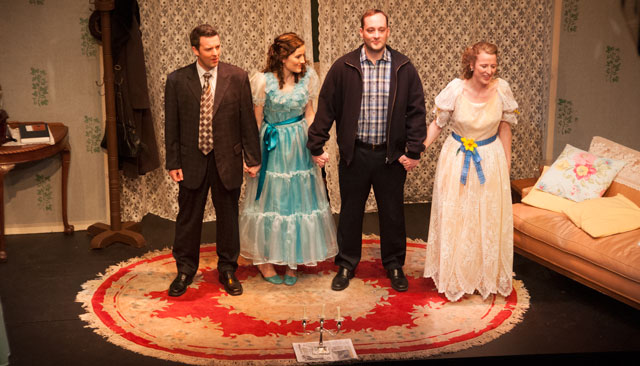 Members of the cast of 'The Glass Menagerie' take a bow at a performance in the Mill Theatre on Saturday 23 March 2013
Members of the cast of 'The Glass Menagerie' take a bow at a performance in the Mill Theatre on Saturday 23 March 2013
Pictures taken at dress rehearsal and final performance on Saturday 23 March 2013
The full set of pictures taken during the performance are in the slideshow above, below the cast and crew credits. Here's a small selection of the many pictures taken. To view and/or download any of the pictures, visit www.balally.smugmug.com to see the '2013 - The Glass Menagerie' gallery and all of the available collections of images.
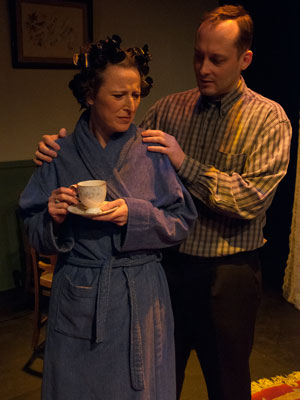
Amanda (Claire O'Donovan) and Tom (Seán Ahern)
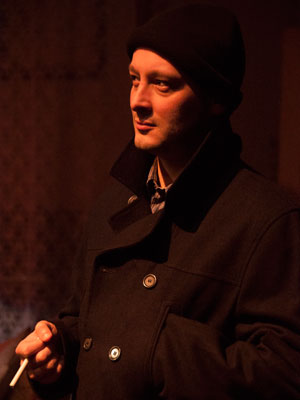
Tom (Seán Ahern)
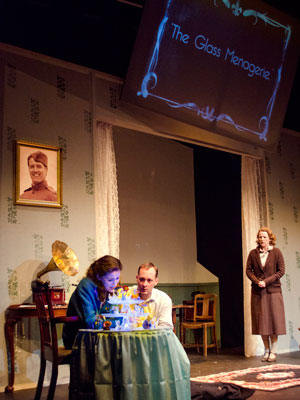
Laura (Caitlín), Tom (Seán) and Amanda (Claire)
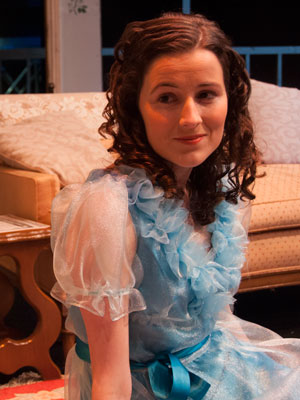
Laura (Caitlín Higgins Ní Chinnéide)
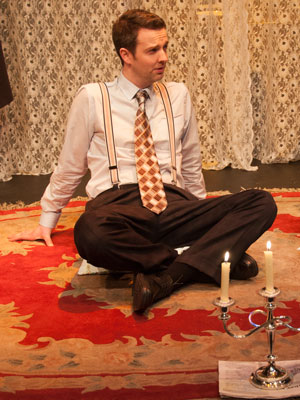
Jim (Declan O'Loughlin)
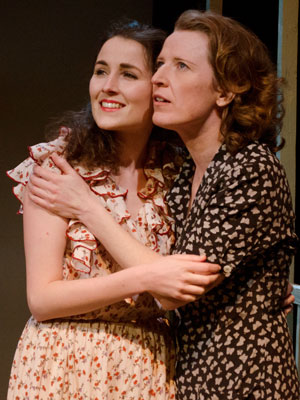
Laura (Caitlín) and Amanda (Claire)
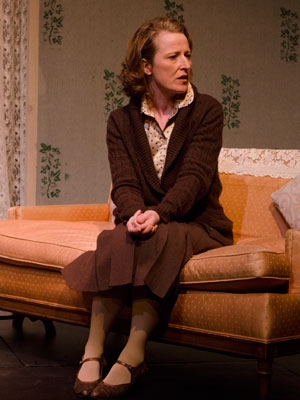
Amanda (Claire O'Donovan)
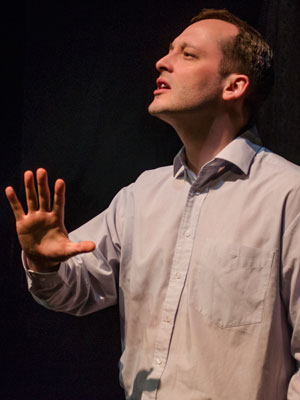
Tom (Seán Ahern)
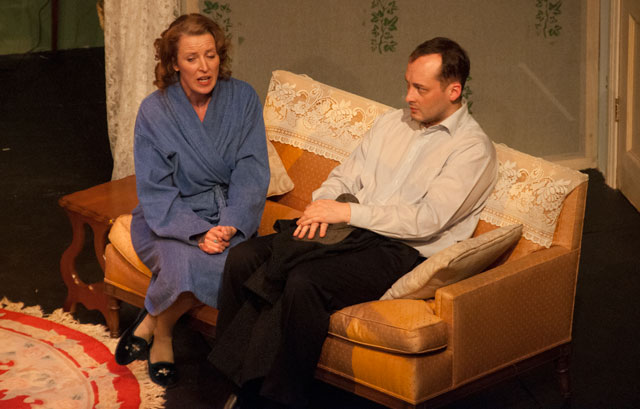 Amanda (Claire O'Donovan) with Tom (Seán Ahern)
Amanda (Claire O'Donovan) with Tom (Seán Ahern)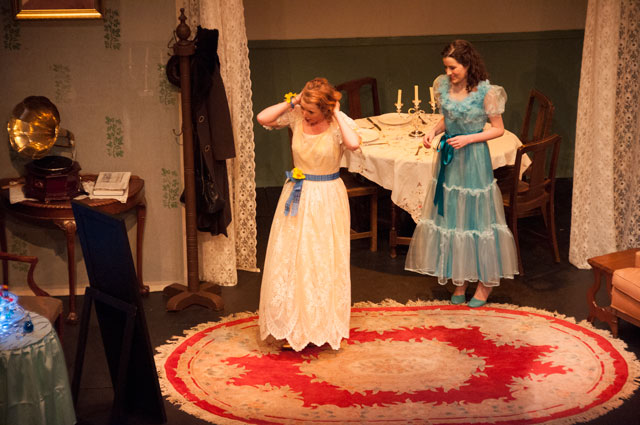 Amanda (Claire O'Donovan) with Laura (Caitlín Higgins Ní Chinnéide)
Amanda (Claire O'Donovan) with Laura (Caitlín Higgins Ní Chinnéide)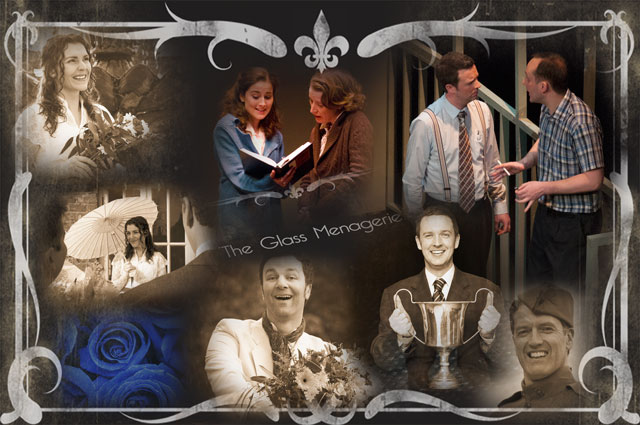 A montage of images including some of those that were projected on the screen above the set. Those who appeared on the screen, but were not characters in the play, were Máirín Condon (Amanda as a young woman) and and Seán Daly (gentleman caller with flowers). Brendan O'Sullivan featured as Amanda's husband, dressed in uniform, for his portrait that was on the wall of the set.
A montage of images including some of those that were projected on the screen above the set. Those who appeared on the screen, but were not characters in the play, were Máirín Condon (Amanda as a young woman) and and Seán Daly (gentleman caller with flowers). Brendan O'Sullivan featured as Amanda's husband, dressed in uniform, for his portrait that was on the wall of the set.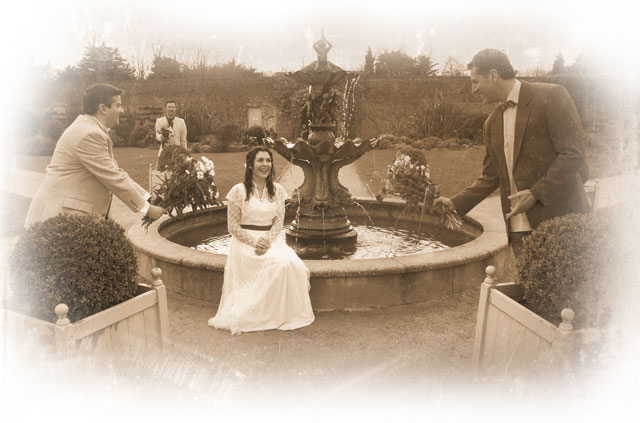 One of the images created for the projections, which did not make it into the final selection, was this one of 'Young Amanda' (Máirín Condon in this picture) surrounded in a faded and embellished memory of her as the focus of the attentions of several Gentlemen Callers. The men in the photograph, which was taken in Marlay Park, are (l-r) Óran O'Rua, Seán Daly and Brendan O'Sullivan.
One of the images created for the projections, which did not make it into the final selection, was this one of 'Young Amanda' (Máirín Condon in this picture) surrounded in a faded and embellished memory of her as the focus of the attentions of several Gentlemen Callers. The men in the photograph, which was taken in Marlay Park, are (l-r) Óran O'Rua, Seán Daly and Brendan O'Sullivan.
